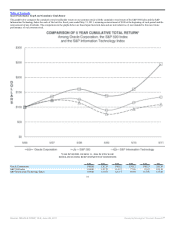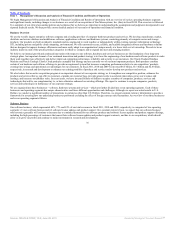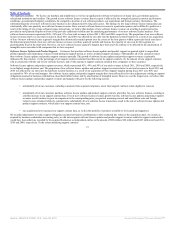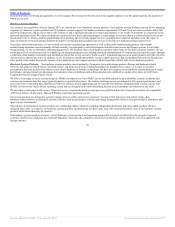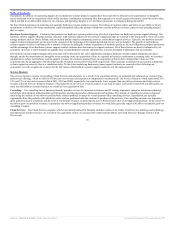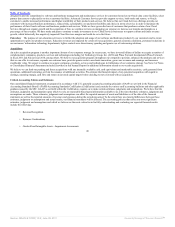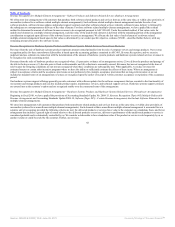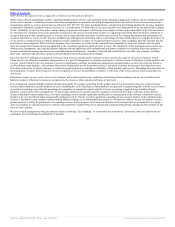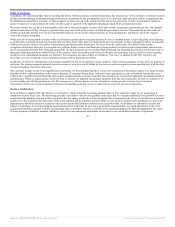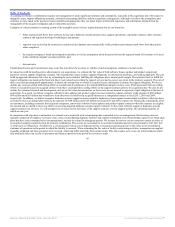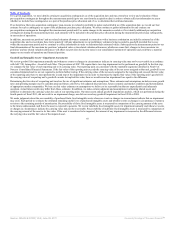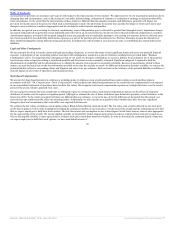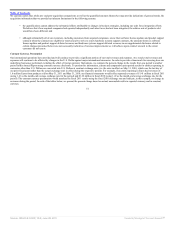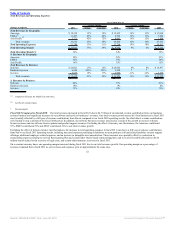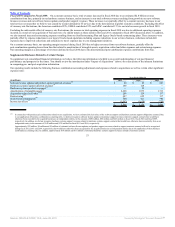Oracle 2010 Annual Report Download - page 48
Download and view the complete annual report
Please find page 48 of the 2010 Oracle annual report below. You can navigate through the pages in the report by either clicking on the pages listed below, or by using the keyword search tool below to find specific information within the annual report.
Table of Contents
Other Revenue Recognition Policies Applicable to Software and Nonsoftware Elements
Many of our software arrangements include consulting implementation services sold separately under consulting engagement contracts and are included as a part
of our services business. Consulting revenues from these arrangements are generally accounted for separately from new software license revenues because the
arrangements qualify as services transactions as defined in ASC 985-605. The more significant factors considered in determining whether the revenues should be
accounted for separately include the nature of services (i.e. consideration of whether the services are essential to the functionality of the licensed product), degree
of risk, availability of services from other vendors, timing of payments and impact of milestones or acceptance criteria on the realizability of the software license
fee. Revenues for consulting services are generally recognized as the services are performed. If there is a significant uncertainty about the project completion or
receipt of payment for the consulting services, revenues are deferred until the uncertainty is sufficiently resolved. We estimate the proportional performance on
contracts with fixed or “not to exceed” fees on a monthly basis utilizing hours incurred to date as a percentage of total estimated hours to complete the project. If
we do not have a sufficient basis to measure progress towards completion, revenues are recognized when we receive final acceptance from the customer that the
services have been completed. When total cost estimates exceed revenues, we accrue for the estimated losses immediately using cost estimates that are based
upon an average fully burdened daily rate applicable to the consulting organization delivering the services. The complexity of the estimation process and factors
relating to the assumptions, risks and uncertainties inherent with the application of the proportional performance method of accounting affects the amounts of
revenues and related expenses reported in our consolidated financial statements. A number of internal and external factors can affect our estimates, including
labor rates, utilization and efficiency variances and specification and testing requirement changes.
Our Cloud Services offerings are comprised of Oracle Cloud Services and Advanced Customer Services and are also a part of our services business. Oracle
Cloud Services are offered as standalone arrangements or as a part of arrangements to customers buying new software licenses or hardware systems products and
services. Oracle Cloud Services are designed to provide comprehensive software and hardware management and maintenance services for customers hosted at
our Oracle data center facilities, select partner data centers or physically on-site at customer facilities. Advanced Customer Services provides support services,
both onsite and remote, to Oracle customers to enable increased performance and higher availability of their products and services. Depending upon the nature of
the arrangement, revenues from Cloud Services are recognized as services are performed or ratably over the term of the service period, which is generally one
year or less.
Education revenues are also a part of our services business and include instructor-led, media-based and internet-based training in the use of our software and
hardware products. Education revenues are recognized as the classes or other education offerings are delivered.
If an arrangement contains multiple elements and does not qualify for separate accounting for the product and service transactions, then new software license
revenues and/or hardware systems products revenues, including the costs of hardware systems products, are generally recognized together with the services based
on contract accounting using either the percentage-of-completion or completed-contract method. Contract accounting is applied to any bundled software,
hardware systems and services arrangements: (1) that include milestones or customer specific acceptance criteria that may affect collection of the software
license or hardware systems product fees; (2) where consulting services include significant modification or customization of the software or hardware systems
product or are of a specialized nature and generally performed only by Oracle; (3) where significant consulting services are provided for in the software license
contract or hardware systems product contract without additional charge or are substantially discounted; or (4) where the software license or hardware systems
product payment is tied to the performance of consulting services. For the purposes of revenue classification of the elements that are accounted for as a single
unit of accounting, we allocate revenues to software and nonsoftware elements based on a rational and consistent methodology utilizing our best estimate of fair
value of such elements.
We also evaluate arrangements with governmental entities containing “fiscal funding” or “termination for convenience” provisions, when such provisions are
required by law, to determine the probability of possible
44
Source: ORACLE CORP, 10-K, June 28, 2011 Powered by Morningstar® Document Research℠


